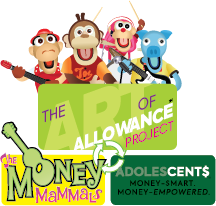
“Working to help parents raise money-smart kids.”
Hi!
Welcome to another edition of 3 Ideas to Share and Save.
Want to get this regularly? You can sign up for the newsletter here.
Let’s get right to it!
— 1 —
ADOLESCENT$: I’m excited to share with you the debut of our new program, ADOLESCENT$. (Here’s a demo of the site.) This portal for tweens and teens is the final piece of The Art of Allowance Project launch. Our mission is to help parents raise money-smart kids, and now ADOLESCENT$ provides a natural transition from our Money Mammals program for younger children to these older kids.
ADOLESCENT$ features media designed to help tweens and teens improve their money smarts. Its first video series highlights five good money habits to help kids learn to think about their future selves. I suggest watching the following two-minute video before continuing with this newsletter, as below I share some thoughts about why we’re taking the approach that we are with ADOLESCENT$.
I first encountered this idea of the future self (Did you take my advice and watch the video yet?) in Daniel Gilbert’s wonderful work, Stumbling on Happiness. My big takeaway from the book: Because we’re not very good at understanding what will make our future selves happy, we should find someone that is living the life we think we want to see if he or she really is happy. I believe this is a meaningful skill — thinking about our future selves — that we can help our kids develop to help them live better, more enriching lives.
— 2 —
Shareable Cards: James Robert Lay, a friend and the author of Banking on Digital Growth (which is terrific, BTW), says that all people want is hope and help. ADOLESCENT$ (and The Art of Allowance Project) is designed to provide both for families. In a consumer-centric world, we help parents feel confident about raising money-smart kids. One of our core messages is that we want children to learn how to use money as a tool to craft meaningful lives. Having control over our money situations gives us the hope that our lives can be fulfilling.
Another way we get our core messages across to tweens and teens is via shareable cards. Here are three examples, one from each of our featured categories: “By the Numbers,” “Money-Smart Habits” and “Money Lifestyle.”
Our hope, of course, is that tweens and teens will share these cards with their friends so that we can help the next generation develop a culture of controlled consumption. This linked article comes from the TOP STORIES section of the new ADOLESCENT$ website and is closely tied to my article for parents on the same subject. The similarity of both pieces highlights a key benefit of The Art of Allowance Project for families. We’ve curated the site’s content so that what kids are reading or watching relates directly to the resources we provide for parents. By doing so, we’ve laid the foundation for connected conversations within families.
— 3 —
How Much Does Free Cost?: You’ve no doubt heard someone say, “Nothing in life is ever free.” My newest short essay addresses the cost of free stuff. Whether it’s robbing us of time (in the case of sales presentations), stealing our attention (in the case of social media) or reducing friction to establish a habit (something I call Subscriptionville), free stuff is something of which we’d be wise to be wary.
Thanks again for taking the time to read this newsletter. If you like what my team and I are doing, then I’d really appreciate it if you could please share this with others who might benefit. And if you have friends with kids who are trying to make sense of a crazy world or if you’d like your local financial institution to adopt The Art of Allowance Project, then let us know so we can contact them.
As always, enjoy the journey.
John, The Chief Mammal
Like what you just read? You can sign up for the newsletter here.

